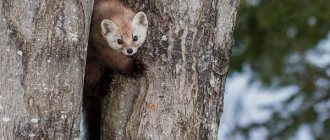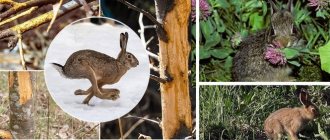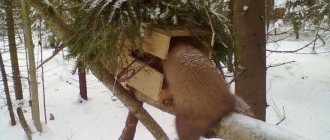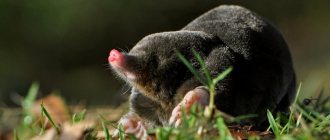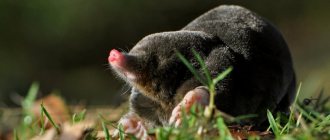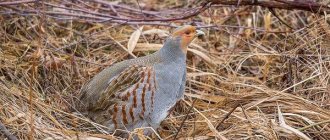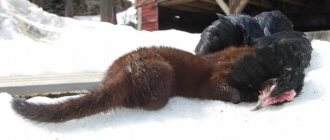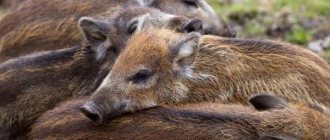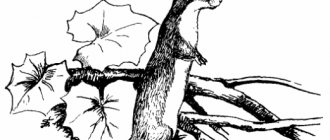The beaver is a representative of the rodent order. The beaver's body length reaches 75–120 cm, with the largest representatives up to 130 cm. The usual body weight is 16–18 kg. There are specimens weighing up to 30 kg. The weight and size of beavers depends on the area where they live, their feeding conditions and existence. Females and males are practically the same in weight and size. The beaver has a cylindrical body shape and streamlined contours, which is most convenient for moving in water. The beaver is an excellent swimmer and diver. The fur of this animal is very hard. The color is dark brown. The tail (a characteristic feature of the beaver) is devoid of hair, flattened horizontally and covered with peculiar scales (they have nothing in common with fish scales). His ears are very small. The eyes are also small. Despite the latter circumstance, beavers' vision is quite sharp. A few words about habitats. In Russia, beavers are common in almost all large rivers, as well as small rivers and rivulets. They live mostly in stagnant or slow-flowing bodies of water. As already mentioned, the strength of a rodent is not enough to overcome a fast current. This is one of the factors determining the construction of dams by beavers. This barrier allows you to make an excellent standing pond from a fast river. Beavers lead an active crepuscular or nocturnal lifestyle. Beavers are monogamous: a pair is created for life, but they most often live in family groups. Beavers have two types of homes: beaver burrows and lodges. A hole is dug in a steep river bank. This dwelling is easier to build, and no river has a steep bank. However, if this does happen, the animals build a complex technical structure - a hut. This is an entire engineering structure, although in appearance it resembles a pile of branches brought by floods. The hut is built from tree branches and soil. The most massive branches are laid at the base in such a way as to support the weight of one or several animals inside. Next, a roof is built above this raft, which, although it has a base in the form of folds of reeds, reeds or cattails, is mostly floating. This creates a living chamber in which the animal hides. There are usually several passages leading into this chamber. As mentioned above, they are all underwater. The main food of beavers in summer consists of green parts of plants, the bark of young trees and other plant foods. In winter, when the green parts of plants die off, beavers feed on the bark of stored tree branches. Beavers' favorite trees are white poplars, aspens and willows. Beavers' teeth, like other rodents, grow throughout their lives. Despite their strength, they wear down during operation. In addition, they are constantly sharpening.
Castoreum
It is worth telling about this organ in a little more detail, since the entire tragic history of the beaver tribe is connected not only with the indefatigable prey of this animal for its most valuable fur, but also with an equally, and sometimes many times more expensive, part of the beaver’s body - the beaver stream. The beaver stream is a pair of pear-shaped sacs that have long been considered the musk glands of the beaver. As studies have shown, these organs do not have a glandular structure, but are highly wrinkled connective tissue formations of epithelial origin. The physiological function of the beaver stream has not been fully studied. It is known, however, that it is involved in calcium metabolism. The urine that gets into these bags undergoes fermentation and is subsequently used to mark the territory. Both males and females have a beaver stream, and although it differs slightly in chemical composition, it is possible that it is associated with sexual activity (marking to attract individuals of the opposite sex, mutual sniffing of males and females). There is some difference in properties: for example, when dried, the contents of females’ sacs lose weight from 5 to 15%, and in adult males - up to 30%. The weight of the beaver stream of an adult animal is 170-200 g; that of young beavers is less. There is no significant difference between males and females in the weight of the pouches. The beaver stream of Canadian beavers is lighter in weight and differs in composition compared to European beavers. In the Middle Ages, Russian, or Siberian, beaver stream was especially valued by healers. The chemical composition and properties of the jet are quite complex and have not been sufficiently studied. It is known that the contents of the stream are dissolved and extracted in alcohol and ether. It is poorly soluble in water and insoluble in acetone and gasoline. The contents of the beaver stream include essential oils, which give the characteristic smell of soaked willow bark, resinous substances, castorin, cholesterol, ammonium carbonate, calcium carbonate, calcium phosphate, salicylic acid, benzoic acid, phenol and other substances. Beaver stream has been used in medicine since ancient times. For a long time it was considered almost a panacea for all diseases. It is mentioned in their works by Hippocrates, Galen, Avicenna, Marius and others. Beaver stream was especially valued in the East. In medieval medical books, castorium (the main active principle of beaver stream) was recommended for use in gynecological diseases, amenorrhea, and especially in various nervous diseases as an anticonvulsant and sedative. Some northern peoples practically did not use beaver skins, but they had a high price for beaver stream, which they used in various rituals and religious practices. Slavic peoples also used beaver stream to treat throat diseases, chest diseases, etc. Unfortunately, many traditional medicine recipes have been lost. It is known that the contents of the bags promote rapid healing of wounds, and a solution in alcohol cures abscesses and boils in a few days. The bactericidal properties of the stream are also evidenced by the fact that the beaver stream bags themselves can be stored for years without undergoing any changes, without being affected by rotting bacteria, mold fungi and even mites. Currently, modern medicine does not deny the healing properties of beaver stream. Salicylic acid, which is the basis of many modern drugs, was originally isolated from willow bark, and, as we know, it is the main component of beaver nutrition. But due to the high cost of preparations made from natural beaver stream and possible counterfeiting on the black market, it is still safer to use industrial medicines. Currently, beaver stream is more widely used in the perfume industry as a fixative for the odors of the most expensive perfumes and gives them a peculiar “animal” smell. The organized beaver fishery that was then still in the USSR, which began in 1963, made it possible to abandon the import of beaver stream and provided the domestic perfume industry with its own raw materials.
How to choose a place to hunt beaver with a gun?
It may be located near the surface of the water or be slightly elevated above it. The first turns out to be quite advantageous if you shoot at animals located on the shore, the second - if the intended victim is in the water. Sometimes hunting binoculars can be useful on such a hunt; they can be used to conveniently observe beavers located at a considerable distance from the hunter.
Although the beaver is a crepuscular animal, if it is often disturbed, it may well switch to a purely nocturnal lifestyle. In such a situation, you will have to use a flashlight.
Beaver hunting with a gun from a boat
This method of hunting involves the hunter silently sailing a boat along a river or stream and shooting beavers. So, the equipment you need is a boat, a gun, a car headlight and a battery. It is better to hunt in this way with two people: one aims the headlight at the animal, the other shoots. The most important thing when hunting in this way is absolute silence and stillness. It is better not to shoot at swimming animals at night. This is just extra noise, which in most cases does not bring trophies, but frightens the beavers living downstream. Collecting trophies is best done in the morning or during a second passage along the channel.
Methods for installing traps
Methods for installing trapsWhen using any method of installing traps, you must adhere to the following rules:
1. Before setting the trap, rub your hands with pine needles or local surrounding shrubs or herbaceous vegetation. Then putting on canvas mittens, take one trap out of the bag, which you also rub with pine needles or twigs and grass. Having alerted him, go with only this one trap and a shovel to the trail where the plane is supposed to be installed, leaving the bag and all the hunting belongings 60-70 meters from the place where the trap was installed.
2. You need to approach the fox trail from the side, from the leeward side, using natural shelter: thickets of bushes, young fir trees, pine trees, piles of dead wood, hummocks, logs, etc., which makes it easier to further camouflage the hunter’s tracks.
3. Do not breathe or cough towards the trap and do not smoke while setting it.
Along a black trail or along shallow and loose snow, a trap is set in the trail (mounted installation of traps). To do this, use a spatula to dig a hole in the ground or snow, the dimensions of which should correspond to the area of the trap and be slightly deeper than its height when alert. Having placed the trap in the hole, cover it with light dry twigs and straws, placing them longitudinally in the direction of the arcs, so that they protect the plate from involuntary descent. Dry leaves are laid on these straws, leaving the tongue of the guard free, and they are sprinkled with dry sand or snow. Then the place where the trap is installed is leveled with the adjacent surface of the earth or snow with a broom made of twigs, a branch of a coniferous tree or a special brush made of horse hair, and snow or sand is carefully raked out over the plate of the trap with a fox or hare's paw, thus making a false imprint of a fox's footprint.
A trap is placed under the footprint using a spatula with a short handle. This method is used when snow falls at a depth of at least 20 centimeters.
Having approached the fox trail at a distance of 1 meter, they place a trap behind themselves. Then, on the side of the fox’s paw print (10-15 centimeters) in the direction of the hunter, a square brick of snow with an area of 25 by 25 centimeters and a height of 15-20 centimeters is cut out with a spatula. Carefully pry up the snow brick with a spatula, take it out and also place it behind you. After this, through the formed hole, they crush the snow under the footprint with a shovel, trying not to touch or destroy the footprint itself - the “chair”, and thus prepare a platform that should be 3-5 centimeters wider than the trap (Fig. 21).
When the area for the trap is prepared, you should carefully trim the footprint and the ceiling above the cave with a spatula (or a small special spatula) from the sides and back so that it is no thicker than 5-7 centimeters, and the trace hangs somewhat from the ceiling in the form of a truncated cone of frozen snow. , squeezed by a fox's paw (Fig. 22).
After all this preparatory work is completed, a trap with winding springs is placed on the end of the blade (with the springs towards itself - in the direction of the blade roll) and placed under the trace. They do this so that the plate is exactly under the footprint.
When installing a trap, it is important to ensure that there is a void under the plate with a depth of at least 5 centimeters, and the distance between the plate and the cone of the snowball around the footprint is no more than 3-5 centimeters.
The snow layer from the bottom to the bottom of the cone, the snowball should be approximately 2-3 centimeters. When installing traps of small numbers, for example No. 1, this layer must be reduced to 1 centimeter, and so that the plate does not show through, a thin layer of snow is poured onto it.
Having set a trap in this way, they immediately bury a chain and drag in the snow in the hole. Then they take the previously removed snow brick, put it in its place and use a spatula (brush) to smooth out the cracks and gaps in the snow. The hunter's tracks are also carefully masked by sprinkling them with snow taken to the side. After all this, they scoop up loose snow into a shovel and, lightly tossing it, dust the camouflaged area with it.
The trap can be: installed using a spatula with a long handle (up to 5-6 meters). This method is also used in snow with a depth of at least 20 centimeters. Its advantage is that it allows you to install a cancan without disturbing the natural virgin snow near the fox track, and therefore does not take time to disguise human tracks.
With this method of setting a trap, they also approach the trail from the side, using natural shelters. Approaching the footprint, to the length of the handle of the shovel (see Fig. 21), it is pulled out and a part of the virgin snow is cut off from the side of the fox paw print, 3-5 centimeters from it, by moving the shovel from top to bottom. After this, the snow is crushed under the footprint and then, placing the blade of the shovel on its edge, they rake the cave to the size of a trap, trying to get the same distance between the surface of the snow and the plate, as in the previous method. In the cave prepared in this way, a guarded Kalkan is placed on the shoulder blade with the springs forward, with a plate under the trace. This method is especially convenient for installing traps of small numbers, equipped with a chain of large rings with a light drag.
Having installed the trap, use a spatula to cut out a snow brick of the appropriate size to the side, which is used to cover the opening of the niche and smooth out the unevenness with the underside of the spatula, sprinkling them with additional loose snow.
If the hunter approached from behind natural cover, then in this case his tracks need not be masked.
— Choosing a place to install traps
The ability to choose places to set traps is a whole science that every hunter can comprehend by practical study of animal habits, which largely depend on the conditions of existence of animals in a particular area and beyond. For example, in remote areas, foxes are afraid to cross freshly laid ski tracks, while in populated areas they willingly use them to save strength during long journeys.
Foxes that regularly visit garbage dumps on the outskirts of cities are not at all afraid of scrap metal and rummage through piles of cans, while foxes from remote areas are afraid of such metal objects. Some foxes are afraid to walk near the fence, while others crawl through drainpipes under the fence. Many more examples could be given of the influence of external conditions on the habits of foxes.
However, despite the various deviations in the habits of foxes, many common characteristic features can be identified that every hunter should keep in mind when choosing places to set traps. First of all, it is characteristic of all foxes that they like to follow their trail several times, and in the same direction, i.e. round. However, these repeated transitions along the same trail occur only in places. They are usually found on difficult to pass sections of the path. It is these that you need to be able to find and, in accordance with the movement of the animal, set and camouflage traps. It should also be borne in mind that foxes very often return to their old roosts. Therefore, the trail to the bed can also be used to set a trap.
A very convenient place to install a trap can be a bush, hummock or post, near which foxes regularly urinate. Such a fox latrine can also be made artificially by sprinkling urine from a freshly killed fox on a post near the fox crossings or by adding ice cubes of collected frozen fox urine.
Traps should also be installed on fox paths - transitions, that is, on tracks along which animals have passed at least 2-3 times, or in places where 2-3 tracks come together. The transitional track of a fox is most often found in hollows, at the bottom of a ravine, along the frozen bed of a spring, etc. The snow in such places is usually deeper, which is why animals often follow the same trail.
In the mountainous southern regions, most rivers do not freeze in winter, and if they do freeze, it is only partially, forming only ice bridges, which are often used by foxes. Traps can also be placed on the trail across such a bridge.
It is quite easy to catch the beast by discovering its storage room. To do this, install two traps on the approach and exit tracks.
To increase the efficiency of trap fishing, many fishermen arrange baits, use a lotask and use various baits. In this case, the traps are not installed near the bait itself, but along the path of the fox’s approach to it - 100-200 meters from the carcass. To do this, they bypass the bait, sticking to thickets of bushes, weeds, etc. Having encountered an entrance or exit fox trail, the hunter, masquerading as bushes, sets a trap on it. Then, going around the bait in the opposite direction and encountering another fox trail, he sets another trap. In this case, it is not recommended to cross fox tracks.
The widely known Siberian hunter F.A. Babin, on the contrary, recommends crossing fox tracks on skis and setting a trap to meet the animal’s progress at the fifth mortar (paw print) from the ski track (Fig. 23). This method of installation is based on the fact that the fox, approaching the ski track, immediately notices it and, concentrating its attention on it, falls into the trap.
To attract a fox to a certain place and force it to follow the path desired by the hunter, on which traps are placed, an odorous trail is laid. To do this, they use a drag - a fresh, or better yet, fried carcass of a fat cat, dog, rabbit, etc., tied on a rope, the insides of a larger animal, or, finally, just a lump of hemp or cotton wool, moistened with rancid blood, rotten eggs, or other odorous bait. Luring foxes by dragging is widely and very successfully used by the experienced hunter of the Solton region of the Altai Territory E.I. Chinchenov. For dragging, he usually uses the corpse of a skinned dog.
It is best to drag a drag through the fox crossings on horseback or on skis. You should drag the bait sideways, tying it to a long stick. After 100-200 meters, a threshold the size of a mitten is made of snow on the trail of the scoundrel, and a clicker is installed behind it. The fox, having reached the threshold, jumps over it and falls into a trap. Sometimes, instead of dragging, they scatter pieces of meat along the ski track, between which they set traps, in this case constructing artificial thresholds or using natural logs. This is done in particular by the hunter of the Arbazhsky district of the Kirov region A.S. Gordeev.
It is necessary to check the installed traps daily or, in any case, at least every other day. It is best to do this in the late morning and afternoon, when the foxes go to strong places. Therefore, you should not get carried away with arranging a large number of traps. A good trap hunter gets one fox in every 3-5 traps he sets. With a large number of foxes, one hunter can set and timely check up to 20 traps.
Large numbers of traps (No. 4 and 5) are placed on fox tracks in such a way that the arcs capture the animal’s paw from the sides. In this case, the springs always move towards the crosspiece almost at a right angle to the frame. Along with this, hunter F.A. Babin, who successfully uses traps No. 1 with double reinforced springs, recommends (and not without reason) installing such small traps with arcs across the track and a cross towards the animal, which, in his opinion, is achieved by achieving a stronger grip of the fox’s “paw” by the fingers.
Beaver hunting with a trap
Many hunters use traps to catch beavers. Beaver hunting with traps is considered one of the most productive ways of hunting this animal.
When to catch a beaver with a trap
The beaver hunting season in Russia is set from October 1 to February 28. Although the hunting dates may vary in each region. The best time to hunt beaver is in the fall, before freeze-up, on the trails laid by beavers on the shore. In winter, it is better to catch beavers with traps on warm days; beavers are not active on cold days. A very catchy time for beaver hunting is in February during thaws, when an opening appears near the shore or at a beaver dam.
What trap to set for a beaver
There are two types of hunting traps: plate leg-grabbing traps and frame walk-through traps. Leg traps are prohibited for use in beaver harvesting for humane reasons. According to current legislation, walk-through traps can be used to catch beavers. Before hunting beaver with traps, you should check whether this method of hunting is legally permitted in your region.
How to set a trap for a beaver
To catch a beaver using a trap, it must be carefully prepared. Immediately before the hunt, traps should be thoroughly cleaned to get rid of metal and human odors. It is necessary to remove all factory grease from the new trap using acetone or gasoline. Then the trap is boiled with bark and branches of coniferous trees. The trap must be dried, and it can only be handled with unused gloves, preferably fabric ones. Some hunters wipe the trap with lime to get rid of foreign odors. It is especially important to prepare the trap well if it will be set on land. A trap installed in water does not need to be treated so carefully.
You need to set the trap during the day. The trap must be tied with a chain or cable to a log, which can be placed on the ice or on the shore. In order to better camouflage a trap installed in water, shake the water around it; after the silt and sand settle on it, it will be reliably camouflaged.
Where to set a trap for a beaver
Beaver traps are placed in places that they most often visit:
- The place where beavers emerge from the water onto land, to the feeding area
- A path made by beavers from one pond to another
- At a specially made gulley in the dam, which beavers will definitely come to repair
- Near stumps, snags, and hummocks, on which beavers place their scent marks to mark their territory.
Beaver traps should be checked regularly.
Preparing to hunt martens
Like any serious business, marten fishing requires careful preparation. To determine the type and number of self-catchers, it is necessary to study the fishing area. A hunting path is being laid on the site. It should run along areas frequented by the chicken.
The site administration reminds you that in accordance with the current legislation of the Russian Federation, the use of standard leg-grabbing retention traps with steel arches for catching pine martens is prohibited! The published material is for informational purposes only and does not encourage readers to catch martens using prohibited methods!
Such places include:
• areas of old forest where there are many fallen trees; • areas of forest where there are bird nests. The marten regularly visits all nests, and birds often sleep there at night. And the predator herself doesn’t mind staying for a day in a cozy bird’s nest; • forest ravines; • forest streams and small rivers, they attract martens like a magnet, there is always something to eat; • rocks and large stone boulders.
In such areas, places for installing self-catchers are prepared in advance. In the fall, bait is laid in these places so that the marten gets used to the place. She thinks that in this place it is safe to eat. The marten does not yet know what kind of reinforcement this is; she will have to pay with her own skin. Preparatory activities include preparing and checking traps and bags.
The agile predator is not afraid of the smell of metal. Therefore, the trap does not require special treatment. It is enough to remove grease and dirt from it. Attention should be paid to attaching the trap, the reliability of the leash and fine-tuning the alert mechanism.
